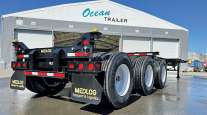Returns of Online Purchases a Key Factor in E-Commerce Boom

While the growth of e-commerce is widely viewed as a boon for last-mile deliveries, customer returns of the merchandise that’s delivered also are forcing change across carriers’ and shippers’ supply chains, industry experts said.
“There are 400 million more packages moving in reverse this year than last,” said Tony Sciarrotta, executive director of the Atlanta-based Reverse Logistics Association. And with those returns exists an opportunity for fleets, he said.
“It’s making trucking get rich.”
UPS Inc. recently debuted Returns Manager, an online management tool to ease the burden of more return volume. Derek Banta, UPS’ director of mobile and digital engagement, told Transport Topics that, according to company data, “about 67% of clients look at a return policy before they make a purchase, especially with online shopping.” And while UPS is not at liberty to discuss any direct link between the tool and an app used at the e-commerce merchant end, but which also benefits the end-customer, Banta could speak to the motivation behind its use.
“We were seeing that return policies were all over the board, and so we wanted a really simple plug-in for the merchant to make their lives easier, as well as simpler for the end-consumer to get packages back to them,” he said.
UPS has a National Returns Day every January and, in 2017, showed that 1.3 million packages had been shipped back to retailers in a single day in 2016, and 5.8 million return packages shipped back the first full week of January. UPS ranks No. 1 on the Transport Topics Top 100 list of the largest North American for-hire carriers.
Retail is estimated as a $5 trillion market, with about 10% of that e-commerce, according to RLA. The organization puts the return rate on in-store purchases at about 8%, but for online shopping, the rate leaps to 25-40%.
The most common category for returned merchandise is shoes and apparel, or 30-35% of e-commerce purchases, “and those returns due to buyer’s remorse could theoretically be resold as new,” Sciarrotta said. “The No. 1 reason for returns is unmet expectations, and there is a price point where people decide whether something is a nuisance or they can just live with it.”
“Reverse logistics is growing at a steady pace, driven by an increase in e-commerce activity,” Ashfaque Chowdhury, president of the XPO Logistics supply chain for the Americas and Asia-Pacific, told Transport Topics. “When there’s growth on the outbound, there is naturally going to be increased inbound activity.
“For example, if you buy four shirts online and return three, sophisticated inventory management is required to take these items back into the system,” Chowdhury said. “The goal is to handle the returns in the most efficient way possible while prioritizing the consumer experience. In an e-commerce world, brand loyalty is being built on the way brands handle returns.”

XPO Logistics
XPO Logistics generally expects most consumer product reverse traffic from January to March, but “seasonality, significant product launches and promotions can also affect these cycles throughout the year,” Chowdhury said. “The consumer electronics industry is a good example. At times, they provide exchange credits for an older product when a new product is launched, and that can drive additional reverse logistics volumes.”
According to a UPS report on online shopping, published with data ending in 2016, even e-commerce buyers still would prefer to return an item to the store than to ship it back to the retailer. UPS data show that 68% of shoppers ship an item back to the retailer, but only 40% prefer this format; 52% return an item to a store, but 60% actually prefer this format.
XPO Logistics works across numerous verticals and handles returns of numerous types of products sold from e-commerce and traditional networks, Chowdhury said. “Along with clothing, footwear and fashion categories, returns in categories like mobile devices and computers are high. Some of the categories are less obvious but still very active, including heavy and bulky products like appliances, furniture and sporting equipment,” he said. “These categories are increasingly being sold through e-commerce and also experiencing increased growth in reverse logistics.”
The supply chain challenges are new, but the basis for this business is rooted in customer-first thinking, Sciarrotta said.
“It was started by Sears 100 years ago, when they offered ‘satisfaction guaranteed,’ ” he said. “We have an entitlement culture; we’ll send back or take back [what we don’t want].”




